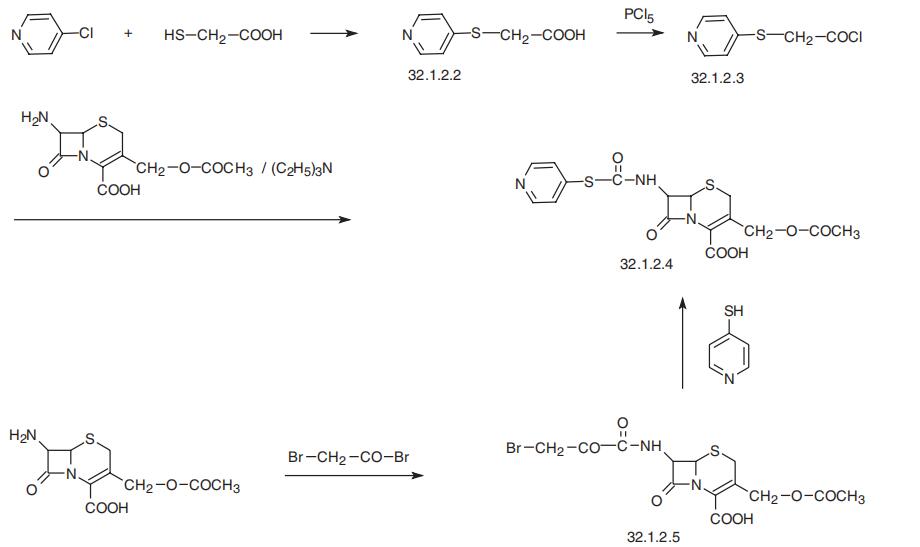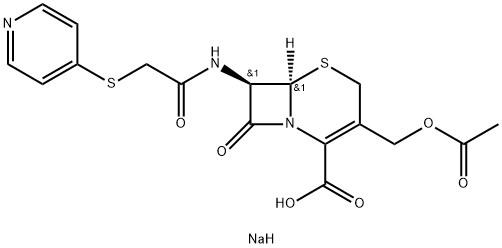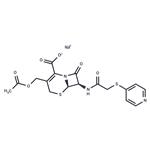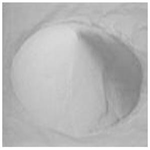Description
Cephapirin sodium (Cefapirin sodium), a semisynthetic cephalosporin antibiotic, is bactericidal against strains of gram-positive and gram-negative bacteria.
Cephapirin is closely resembles cephalothin in chemical and pharmacokinetic properties. Cephapirin, have cephalosporanic acid core with the acetyloxymethyl group at the 3rd position and having IUPAC name (6R,7R)-3-(Acetoxymethy)-8- oxo-7-{[(pyridin-4-ylsulfanyl)acetyl]amino}-5-thia- 1-azabicyclo [4.2.0] oct-2-ene-2-carboxylic acid. It is unstable in acid and must be administered parenteral. It has similar mechanism as other cephalosporins. It is marketed under the trade name Cefadyl. It is effective against a wide variety of gram-positive and gramnegative bacteria; used as the sodium salt. Among the most serious adverse reactions of cefapirin, that is, neutropenia, leukopenia, anemia, bone marrowdepression, and allergic reactions, it has been discontinued in the United States (Wiesner, 1972).
Chemical Properties
White or pale yellow powder.
Originator
Cefadyl,Bristol,US,1974
Uses
Cefapirin sodium is very similar to cephalothin (Bran et al., 1972). Cephapirin is
now used almost exclusively in veterinary practice.
Application
Cephapirin was synthesized by BristolMyers Laboratories in 1970. It shows almost the same in vitro antibacterial activity as cephalothin, but its in vivo effects are slightly greater than those of cephalothin. Like cephalothin, it is metabolized in vivo, and its deacetylated metabolite shows almost the same activity against gram-positive bacteria as cephalothin, but weaker activity against gramnegative bacteria. Cephapirin has been used for therapy of urinary tract infections and osteomyelitis caused by Staphylococcus, Streptococcus, and Escherichia coli.
Definition
ChEBI: Cephapirin sodium is the sodium salt of cephapirin. A first-generation cephalosporin antibiotic, it is effective against gram-negative and gram-positive organisms. Being more resistant to beta-lactamases than penicillins, it is effective agains most staphylococci, though not methicillin-resistant staphylococci. It has a role as an antibacterial drug. It is a cephalosporin and an organic sodium salt. It contains a cephapirin(1-).
brand name
Cefadyl (Apothecon), ToDAY
Therapeutic Function
Antibacterial
Synthesis
Cephapirin, (6R-trans)-3-[(acetyloxy)methyl]-8-oxo-7-[[(4-pyridinylthio)
acetyl]amino]-5-thia-1-azabicyclo[4.2.0]oct-2-en-2-carboxylic acid (32.1.2.4), is synthesized by acylating 7-aminocephalosporanic acid with 4-pyridylthioacetic acid chloride
(32.1.2.3), which is synthesized by reacting 4-chloropyridine with mercaptoacetic acid in
the presence of a base, forming 4-pyridylthioacetic acid (32.1.22), and further transforming the resulting acid to the acid chloride by reacting it with phosphorous pentachloride.
An alternative way of making cephapirin is the acylation of 7-aminocephalosporanic acid
by bromoacetyl bromide, which gives a bromoacetyl derivative (32.1.2.5), and which is
then reacted with 4-mercaptopyridine in the presence of triethylamine, forming the desired
cephapirin (32.1.2.4).







